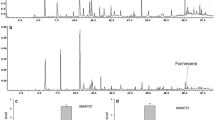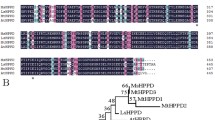Abstract
We previously isolated a soybean (Glycine max (L.) Merr.) flavonoid 3′-hydroxylase (F3′H) gene (sf3′h1) corresponding to the T locus, which controls pubescence and seed coat color, from two near-isogenic lines (NILs), To7B (TT) and To7G (tt). The T allele is also associated with chilling tolerance. Here, Western-blot analysis shows that the sf3′h1 protein was predominantly detected in the hilum and funiculus of the immature seed coat in To7B, whereas sf3′h1 was not detected in To7G. A truncated sf3′h1 protein isolated from To7G was detected only upon enrichment by immunoprecipitation. An analysis using diphenylboric acid 2-aminoethyl ester (DBPA) staining revealed that flavonoids accumulated in the hilum and the funiculus in both To7B and To7G. Further, the scavenging activity of the 1,1-diphenyl-2-picrylhydrazyl (DPPH) radical in methanol extracts from the funiculus and hilum of To7B was higher than that of To7G. Moreover, the enzymatic activity of F3′H was detected using microsomal fractions from yeast transformed with sf3′h1 from To7B, but not from To7G. These results indicate that sf3′h1 is involved in flavonoid biosynthesis in the seed coat and affects the antioxidant properties of those tissues. As shown by immunofluorescence microscopy, the sf3′h1 protein was detected primarily around the vacuole in the parenchymatic cells of the hilum in To7B. Further immunoelectron microscopy detected sf3′h1 protein on the membranous structure of the vacuole. Based on these observations, we conclude that F3′H, which is a cytochrome P450 monooxygenase and has been found to be localized to the ER in other plant systems, is localized in the tonoplast in soybean.






Similar content being viewed by others
Abbreviations
- CYP:
-
Cytochrome P450
- DAPI:
-
4′-6-Diamidino-2-phenylindole
- DPBA:
-
Diphenylboric acid 2-aminoethyl ester
- DPPH:
-
1,1-Diphenyl-2-picrylhydrazyl
- F3′H:
-
Flavonoid 3′-hydroxylase
- HPLC:
-
High-performance liquid chromatography
- NILs:
-
Near-isogenic lines
- ROS:
-
Reactive oxygen species
References
Agati G, Matteini P, Goti A, Tattini M (2007) Chloroplast-located flavonoids can scavenge singlet oxygen. New Phytol 174:77–89
Akashi T, Aoki T, Ayabe S (1999) Cloning and functional expression of a cytochrome P450 cDNA encoding 2-hydroxyisoflavonone synthase involved in biosynthesis of the isoflavonoid skeleton in licorice. Plant Physiol 121:821–828
Alemanno L, Ramos T, Gargadenec A, Andary C, Ferriere N (2003) Localization and identification of phenolic compounds in Theobroma cacao L. somatic embryogenesis. Ann Bot 92:613–623
Aoki T, Akashi T, Ayabe S (2000) Flavonoids of leguminous plants: structure, biological activity, and biosynthesis. J Plant Res 113:475–488
Blots MS (1958) Antioxidant determinations by the use of a stable free radical. Nature 26:1199–1200
Brugliera F, Barri-Rewell G, Holton TA, Mason J (1999) Isolation and characterization of a flavonoid 3′-hydroxylase cDNA clone corresponding to the Ht1 locus of Petunia hybrida. Plant J 19:441–451
Buer CS, Muday GK (2004) The transparent testa4 mutation prevents flavonoid synthesis and alters auxin transport and the response of Arabidopsis roots to gravity and light. Plant Cell 16:1191–1205
Buttery BR, Buzzell RI (1973) Varietal differences in leaf flavonoids of soybeans. Crop Sci 13:103–106
Buzzell RI, Buttery BR, MacTavish DC (1987) Biochemical genetics of black pigmentation of soybean seed. J Hered 78:53–54
Dhaubhadel S, McGarvey BD, Williams R, Gijzen M (2003) Isoflavonoid biosynthesis and accumulation in developing soybean seeds. Plant Mol Biol 53:733–743
Djordjevic MA, Redmond JW, Batley M, Rolfe BG (1987) Clovers secrete specific phenolic compounds which either stimulate or repress nod gene expression in Rhizobium trifolii. EMBO J 6:1173–1179
Donaldson RP, Luster DG (1991) Multiple forms of plant cytochromes P-450. Plant Physiol 96:669–674
Forkmann G, Heller W, Grisebach H (1980) Anthocyanin biosynthesis in flowers of Matthiola incana flavanone 3- and flavonoid 3′-hydroxylases. Z Naturforsch C Biosci 35:691–695
Halbwirth H (2010) The creation and physiological relevance of divergent hydroxylation patterns in the flavonoid pathway. Int J Mol Sci 11:591–621
Havaux M, Kloppstech K (2001) The protective functions of carotenoid and flavonoid pigments against excess visible radiation at chilling temperature investigated in Arabidopsis npq and tt mutants. Planta 213:953–966
Heller W, Forkmann G (1994) Biosynthesis of flavonoids. In: Harborne JB (ed) The flavonoids. Chapman and Hall, London, pp 495–535
Hirokawa T, Boon-Chieng S, Mitaku S (1998) SOSUI: classification and secondary structure prediction system for membrane proteins. Bioinformatics 14:378–379
Höfte H, Chrispeels MJ (1992) Protein sorting to the vacuolar membrane. Plant Cell 4:995–1004
Holton TA, Cornish EC (1995) Genetics and biochemistry of anthocyanin biosynthesis. Plant Cell 7:1071–1083
Hrazdina G (1992) Compartmentation in aromatic metabolism. In: Stafford HA, Ibrahim RK (eds) Phenolic metabolism in plants. Plenum Press, New York, pp 1–23
Hsieh K, Huang AHC (2007) Tapetosomes in Brassica tapetum accumulate endoplasmic reticulum–derived flavonoids and alkanes for delivery to the pollen surface. Plant Cell 19:582–596
Inoue K, Motozaki A, Takeuchi Y, Mikio N, Hara-Nishimura I (1995) Molecular characterization of proteins in protein-body membrane that disappear most rapidly during transformation of protein bodies into vacuoles. Plant J 7:235–243
Iwashina T, Benitez ER, Takahashi R (2006) Analysis of flavonoids in pubescence of soybean near-isogenic lines for pubescence color loci. J Hered 97:438–443
Jiayang L, Tsai-Mei OL, Richard R, Robert GA, Robert LL (1993) Arabidopsis flavonoid mutants are hypersensitive to UV-B irradiation. Plant Cell 5:171–179
Kaltenbach M, Schröder G, Schmelzer E, Lutz V, Schröder J (1999) Flavonoid hydroxylase from Catharanthus roseus: cDNA, heterologous expression, enzyme properties and cell-type specific expression in plants. Plant J 19:183–193
Kuroiwa H, Kuroiwa T (1992) Giant mitochondria in the mature egg cell of Pelargonium zonale. Protoplasma 168:184–188
Kuroiwa T, Nishibayashi S, Kawano S, Suzuki T (1981) Visualization of DNA in various phages (T4, χ, T7, ϕ29) by ethidium bromide epi-fluorescent microscopy. Experientia 37:969–971
Kytridis VP, Manetas Y (2006) Mesophyll versus epidermal anthocyanins as potential in vivo antioxidants: evidence linking the putative antioxidant role to the proximity of oxy-radical source. J Exp Bot 57:2203–2210
Laemmli UK (1970) Cleavage of structural proteins during the assembly of the head of bacteriophage T4. Nature 227:680–685
Larson RL, Bussard JB (1986) Microsomal flavonoid 3′-monooxygenase from maize seedlings. Plant Physiol 80:483–486
Madyastha KM, Ridgway JE, Dwyer JG, Coscia CJ (1977) Subcellular localization of a cytochrome P-450-dependent monooxygenase in vesicles of the higher plant Catharanthus roseus. J Cell Biol 72:302–331
Menting JGT, Scopes RK, Stevenson TW (1994) Characterization of flavonoid 3′,5′-hydroxylase in microsomal membrane fraction of Petunia hybrida flowers. Plant Physiol 106:633–642
Nagamatsu A, Masuta C, Senda M, Matsuura H, Kasai A, Hong JS, Kitamura K, Abe J, Kanazawa A (2007) Functional analysis of soybean genes involved in flavonoid biosynthesis by virus-induced gene silencing. Plant Biotechnol J 5:778–790
Nagamatsu A, Masuta C, Matsuura H, Kitamura K, Abe J, Kanazawa A (2009) Down-regulation of flavonoid 3′-hydroxylase gene expression by virus-induced silencing in soybean reveals the presence of a threshold mRNA level associated with pigmentation in pubescence. J Plant Physiol 166:32–39
Olsen KM, Hehn A, Jugdé H, Slimestad R, Larbat R, Bourgaud F, Lillo C (2010) Identification and characterization of CYP75A31, a new flavonoid 3′,5′-hydroxylase, isolated from Solanum lycopersicum. BMC Plant Biol 10:21–32
Ono E, Hatayama M, Isono Y, Sato T, Watanabe R, Yonekura-Sakakibara K, Fukuchi-Mizutani M, Tanaka Y, Kusumi T, Nishino T, Nakayama T (2006) Localization of a flavonoid biosynthetic polyphenol oxidase in vacuoles. Plant J 45:133–143
Peer WA, Brown DE, Tague BW, Muday GK, Taiz L, Murphy AS (2001) Flavonoid accumulation patterns of transparent testa mutants of Arabidopsis. Plant Physiol 126:536–554
Peters NK, Long SR (1988) Alfalfa root exudates and compounds which promote or inhibit induction of Rhizobium meliloti nodulation genes. Plant Physiol 88:396–400
Poulos TL, Finzel BC, Gunsales IC, Wagner GC, Kraut J (1985) The 2.6-A crystal structure of Pseudomonas putida cytochrome P-450. J Biol Chem 260:16122–16130
Pourcel L, Routaboul JM, Cheynier V, Lepiniec L, Debeaujon I (2007) Flavonoid oxidation in plants: from biochemical properties to physiological functions. Trends Plant Sci 12:29–36
Pratt DE (1976) Role of flavones and related compounds in retarding lipid-oxidative flavor changes in foods. In: Charalambous G, Katz I (eds) Phenolic, sulfur, and nitrogen compounds in food flavors. ACS symposium series 26. American Chemical Society, Washington, DC, pp 1–13
Raikhel N, Chrispeels MJ (2000) Protein sorting and vesicle traffic. In: Buchanan BB, Gruissem W, Jones RL (eds) Biochemistry & molecular biology of plants. American Society of Plant Physiologists, Rockville, MD, pp 160–201
Redmond JW, Batley M, Djordjevic MA, Innes RW, Kuempel PL, Rolfe BG (1986) Flavones induce expression of nodulation genes in Rhizobium. Nature 323:632–635
Rice-Evans CA, Miller NJ, Bolwell PG, Bramley PM, Pridham JB (1995) The relative antioxidant activities of plant-derived polyphenolic flavonoids. Free Radic Res 22:375–383
Rice-Evans CA, Miller NJ, Paganga G (1996) Structure-antioxidant activity relationships of flavonoids and phenolic acids. Free Radic Biol Med 20:933–956
Salaita L, Kar RK, Majee M, Downie AB (2005) Identification and characterization of mutants capable of rapid germination at 10°C from activation-tagged lines of Arabidopsis thaliana. J Exp Bot 56:2059–2069
Saslowsky D, Winkel-Shirley B (2001) Localization of flavonoid enzymes in Arabidopsis roots. Plant J 27:37–48
Schoenbohm C, Martens S, Elder C, Forkmann G, Weisshaar B (2000) Arabidopsis thaliana flavonoid 3′-hydroxylase gene and functional expression of the encoded P450 enzyme. Biol Chem 381:749–753
Takahama U, Oniki T (1997) A peroxidase/phenolics/ascorbate system can scavenge hydrogen peroxide in plant cells. Physiol Plant 101:845–852
Takahashi R (1997) Association of soybean genes I and T with low-temperature induced seed coat deterioration. Crop Sci 37:1755–1759
Takahashi R, Asanuma S (1996) Association of T gene with chilling tolerance in soybean. Crop Sci 36:559–562
Takahashi R, Benitez ER, Funatsuki H, Ohnishi S (2005) Soybean maturity and pubescence color genes improve chilling tolerance. Crop Sci 45:1387–1393
Takahashi R, Dubouzet JG, Matsumura H, Yasuda K, Iwashina T (2010) A new allele of flower color gene W1 encoding flavonoid 3′,5′-hydroxylase is responsible for light purple flowers in wild soybean Glycine soja. BMC Plant Biol 10:155–164
Toda K, Yang D, Yamanaka N, Watanabe S, Harada K, Takahashi R (2002) A single-base deletion in soybean flavonoid 3′-hydroxylase gene is associated with gray pubescence color. Plant Mol Biol 50:187–196
Toda K, Takahashi R, Iwashina T, Hajika M (2011) Difference in chilling–induced flavonoid profiles, antioxidant activity and chilling tolerance between soybean near-isogenic lines for the pubescence color gene. J Plant Res 124:173–182
Todd JJ, Vodkin LO (1993) Pigmented soybean (Glycine max) seed coats accumulate proanthocyanidins during development. Plant Physiol 102:663–670
Watson CJW, Froehlich JE, Josefsson CA, Chapple C, Durst F, Benveniste I, Coolbaugh RC (2001) Localization of CYP86B1 in the outer envelope of chloroplasts. Plant Cell Physiol 42:873–878
Winkel-Shirley B (2001) Flavonoid biosynthesis. A colorful model for genetics, biochemistry, cell biology, and biotechnology. Plant Physiol 126:485–493
Wuyts N, Lognay G, Swennen R, De Waele D (2006) Nematode infection and reproduction in transgenic and mutant Arabidopsis and tobacco with an altered phenylpropanoid metabolism. J Exp Bot 57:2825–2835
Zabala G, Vodkin LO (2003) Cloning of the pleiotropic T locus in soybean and two recessive alleles that differentially affect structure and expression of the encoded flavonoid 3′ hydroxylase. Genetics 16:295–309
Author information
Authors and Affiliations
Corresponding author
Rights and permissions
About this article
Cite this article
Toda, K., Kuroiwa, H., Senthil, K. et al. The soybean F3′H protein is localized to the tonoplast in the seed coat hilum. Planta 236, 79–89 (2012). https://doi.org/10.1007/s00425-012-1590-5
Received:
Accepted:
Published:
Issue Date:
DOI: https://doi.org/10.1007/s00425-012-1590-5




